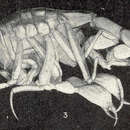en
names in breadcrumbs


Phronima is a genus of small, deep sea hyperiid amphipods of the family Phronimidae. It is found throughout the world's oceans, except in polar regions.[1] Phronima species live in the pelagic zone of the deep ocean. Their bodies are semitransparent. Although commonly known as parasites, they are more technically correctly called parasitoids.[2] Instead of constantly feeding on a live host, females attack salps, using their mouths and claws to eat the animal and hollow out its gelatinous shell.[3] Phronima females then enter the barrel and lay their eggs inside, then propel the barrel through the water as the larvae develop, providing them with fresh food and water.[3]
The genus Phronima contains these species:[4]
Phronima is a genus of small, deep sea hyperiid amphipods of the family Phronimidae. It is found throughout the world's oceans, except in polar regions. Phronima species live in the pelagic zone of the deep ocean. Their bodies are semitransparent. Although commonly known as parasites, they are more technically correctly called parasitoids. Instead of constantly feeding on a live host, females attack salps, using their mouths and claws to eat the animal and hollow out its gelatinous shell. Phronima females then enter the barrel and lay their eggs inside, then propel the barrel through the water as the larvae develop, providing them with fresh food and water.